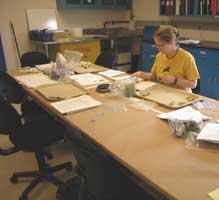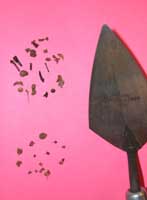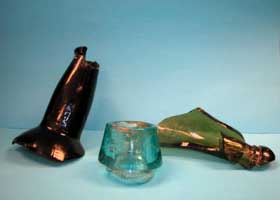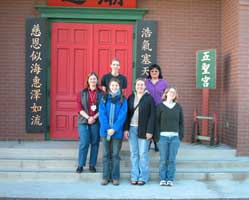My name is Cameron Matthews and I am a junior economics major. I am considering a double major in archaeology and am also on the Stanford baseball team. This past week has been spent learning how to recognize and classify metal artifacts. The metal found in the San Jose Chinatown site has mainly been iron and copper alloys. Iron (pretty obviously) can be identified by the rust corrosion on the object. Rust goes deep into an object and can make it hard to discern what the original object was. Some common ferrous artifacts at the Market Street site are nails, cans, and metal strapping. Nails come in several varieties which follow the chronology of hand-wrought nails, cut nails, and wire nails. Because of this they are very useful in dating a site. Copper, on the other hand, is protected by the green petina that develops on the outside. Common copper or copper alloy artifacts are coins and piping.
One of the more interesting features of metal artifacts is how they interact with other objects nearby. Iron rust has the useful property of taking the form of whatever it is next too as it is corroding. A rusty nail in lumber will fill in the cracks in the decaying wood and a random piece of ferrous metal in a trash pile will swallow up a piece of glass it is lying next to as the corrosion grows outward, as we have observed in numerous examples from the Market Street site. Copper and copper alloys also interact with neighboring objects as they corrode. The bright green petina transfers to pieces of charcoal, leather, and clothing if they are in contact. This creates some minor problems figuring out what different objects are as it makes non-metallic artifacts look like copper pieces. Also, copper takes an imprint of whatever it is next to as the petina develops. It’s pretty cool to see weave patterns from clothing imprinted on copper buttons, even though the clothing has long since decayed.
Featured Artifact
This weeks artifact of the weeks is mix of different materials that probably went together at one time to make up a shoe. The majority of this artifact is a piece of burned leather. When I first saw the object, I thought it was a piece of bone as I had not seen burned leather before. It is surprisingly light weight and looks a lot like bone with the hard outside and porous inside. You can see the green it has taken on from the contact with the copper nails, one of which is still in a hole in the leather. Another shoe component, a piece of wood, is also stuck to the leather. This is a great piece and the detail is amazing. You can see the holes in the charred leather where it was stitched to another piece of the shoe.








